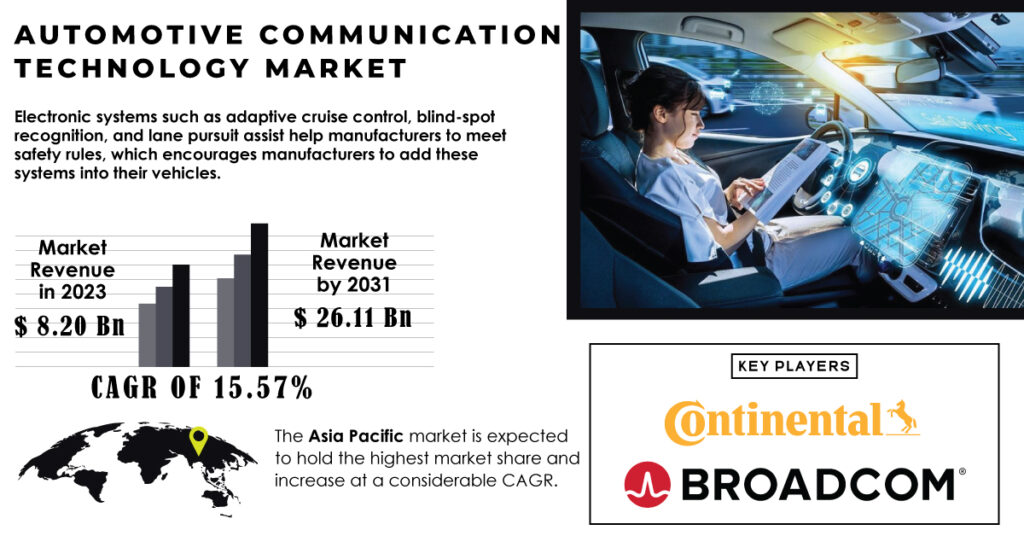
The Automotive Communication Technology Market, valued at USD 8.20 billion in 2023, is projected to reach USD 26.11 billion by 2031, registering a robust CAGR of 15.57% from 2024 to 2031.
Market Scope:
Automotive communication technology refers to the network of computer systems enabling vehicles and roadside units to share information and data, including safety warnings and traffic updates. It plays a crucial role in intelligent transportation systems, allowing drivers to be part of a more reliable and efficient network. This technology finds widespread application in powertrain systems, enhancing safety and reducing traffic collisions.

Automotive Communication Technology Market
Download Free Sample Report of Automotive Communication Technology Market @ https://www.snsinsider.com/sample-request/1026
Various bus modules like Controller Area Network (CAN), Ethernet, Flexray, Local Interconnect Network (LIN), and Media-Oriented Systems Transport (MOST) facilitate communication within vehicles. These modules are predominantly used in powertrain, body control & comfort, infotainment & communication, and safety & ADAS systems.
The automotive communication technology market comprises a diverse range of stakeholders, including automotive manufacturers, suppliers, technology providers, and service providers. Key growth drivers include the increasing complexity of vehicle electronics, the growing demand for ADAS, connected car services, and the development of autonomous vehicles.
Market Analysis:
The need to reduce fuel emissions and enhance vehicle safety are major factors propelling market growth. Additionally, the rising sales of luxury cars and the paradigm shift towards self-driving vehicles are expected to significantly contribute to market expansion. The growing popularity of automotive electronics has also played a significant role in driving market growth.
However, certain challenges exist, such as the high cost associated with communication nodes and the complexity of electronic designs, which might limit market growth. Additionally, the increasing complexity and potential unreliability of electronics architecture could hinder growth during the forecast period.
The deployment of 5G networks presents immense potential for the automotive communication technology market. 5G offers ultra-high-speed, low-latency, and high-reliability communication, making it ideal for connected cars, autonomous vehicles, and V2X communication. Opportunities exist for technologies that enable seamless integration of automotive systems with 5G networks, enabling enhanced connectivity, data exchange, and new services.
Segment Analysis:
By Application:
- Powertrain
- Body Control & Comfort
- Infotainment & Communication
- Safety & ADAS
By Application:
This segment encompasses video and audio content, social networking, communication, games, navigation features, rear parking assistance, and vehicle diagnostics, driving market demand. CAN and MOST networks are primarily used in this application, facilitating efficient communication and transmission of all types of infotainment data within a vehicle.
By Bus Module:
- Local Interconnect Network (LIN)
- Media-Oriented Systems Transport (MOST)
- Controller Area Network (CAN)
- FlexRay
- Ethernet
By Bus Module:
Ethernet technology has revolutionized the automotive industry, offering advantages like low cost, increased bandwidth, synchronization, flexibility, and scalability. This makes it ideal for rapidly changing platforms and developing automotive series. The growing demand for in-vehicle networking technology highlights the potential of automotive ethernet.
By Vehicle Class:
- Economy
- Luxury
- Mid-Size
By Vehicle Class:
The use of sophisticated communication technologies in this segment is driven by rapid technological advancements. High-end automobile manufacturers have integrated technologies like adaptive cruise control, ADAS, active chassis stability, and infotainment into their vehicles over the past decade to provide enhanced comfort and safety to consumers.
Click Here, if you have Any Enquiry about this Research Report @ https://www.snsinsider.com/enquiry/1026
Impact of Russia-Ukraine War:
The ongoing conflict between Russia and Ukraine has disrupted global supply chains, impacting the automotive industry. This has led to shortages of key components and materials, including semiconductors, which are crucial for automotive communication technology. Additionally, the war has caused a rise in energy prices, leading to increased production costs for automotive manufacturers. These factors are expected to have a short-term negative impact on the growth of the automotive communication technology market.
Impact of Economic Slowdown:
A economic slowdown could potentially lead to decreased consumer spending, impacting the demand for new vehicles. This, in turn, could affect the demand for automotive communication technologies. However, the long-term outlook for the market remains positive due to the increasing focus on safety, fuel efficiency, and the development of autonomous vehicles.
Key Regional Developments:
The Asia Pacific market is expected to hold the highest market share and witness significant growth during the forecast period. This growth can be attributed to rising car production, regulatory mandates for active and passive vehicle safety, and increasing infrastructure investment and construction activity. Additionally, the growing sales of luxury automobiles in this region are expected to further boost market expansion.
Key Takeaways from the Automotive Communication Technology Market Study:
- The market is expected to reach USD 26.11 billion by 2031, growing at a CAGR of 15.57%.
- The increasing demand for ADAS, connected car services, and autonomous vehicles is driving market growth.
- The regional market that is anticipated to experience the highest growth is Asia Pacific.
- Technological advancements, rising sales of premium vehicles, and untapped potential in emerging markets offer promising growth opportunities.
- The deployment of 5G networks and the increasing use of data analytics and AI present significant opportunities for the market.
Prominent Key Players of Automotive Communication Technology Market
- Robert Bosch
- Broadcom Inc.
- NXP Semiconductors N.V.
- Infineon Technologies AG
- ON Semiconductor
- Continental AG
- Toshiba Corporation
- Texas Instruments
- Renesas Electronics Corporation
Recent Developments:
April 2024: Elektrobit announced EB zoneo Gateway Core, the first software product enabling the configuration and integration of the new generation of hardware accelerators for advanced automotive electrical/electronic architectures based on the widely adopted Classic AUTOSAR standard.
September 2023: Panasonic Holdings Corporation announced that its Wavelet OFDM technology was approved as Draft 1.0 of IEEE P1901c by the working group under the IEEE Standards Association. This next-generation communication standard allows the same modulation and demodulation method to be used across various communication media, including wired, wireless, and underwater communication.
Access Detailed Research Insight with Full TOC and Graphs @ https://www.snsinsider.com/reports/automotive-communication-technology-market-1026
Our Related Report



